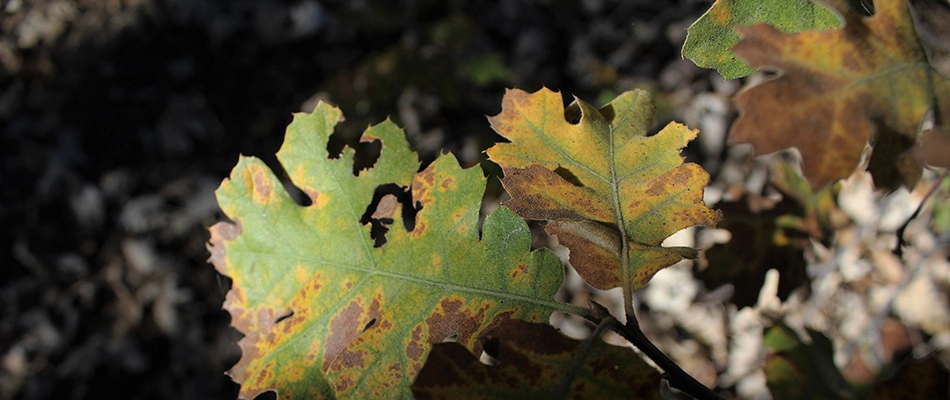Oak trees are a beautiful addition to any property, but to keep them that way, you need to keep your eye out for some oak tree diseases. In Iowa, keep an eye out for bur oak blight, oak wilt, and oak cankers. All three diseases can be very harmful to the health and appearance of your trees. If you suspect that your trees may have any of these diseases, it's best to call a professional tree care company to come to take a look.
1. Bur Oak Blight
Bur oak blight is a type of oak disease that is caused by a fungal pathogen. It typically affects small-acorn oak trees in the mid-to-late summer and early fall. The disease starts in the lower canopy of the tree and works its way up. Two common symptoms include leaf browning and rapid leaf loss. Luckily, bur oak blight will not kill the limbs on your tree! A bur oak tree can withstand losing most of its leaves, but this can cause stress after several consecutive years. It's unlikely the tree will die from bur oak blight, but it's best to treat it as soon as possible so that it doesn't have long-lasting impacts on your tree from year to year.
2. Oak Wilt

Oak wilt is a serious disease caused by a fungal pathogen that affects red oaks more than other trees. Red oaks experience more severe symptoms and are more susceptible to the disease's effects. Oak wilt can spread in a few different ways. Symptoms will usually start to appear around late spring and mid-summer. Starting at the top of the tree, leaves will wilt, die, and fall off the tree. Spore mats and pressure pads will arise and rupture the bark. If you start to see signs of oak wilt, act fast because it spreads pretty quickly.
Oak wilt travels both above ground and underground. Above ground, the spore mats in the bark attract sap-feeding beetles that spread the disease as they travel from tree to tree. Oak wilt spreads underground through the roots in the soil and passes the disease from tree to tree. It can also be spread between logs and firewood.
White oak trees have a better chance of recovering from oak wilt disease than other types of oak trees.
3. Oak Cankers
Oak cankers affect most kinds of oak trees in the winter and early spring. They are typically caused by stresses like drought, heat, wounds, or chemical injuries. Early symptoms of oak cankers usually include the yellowing and wilting of leaves at the back of the tree's crown. Fungal tissue may then form on the bark. In more severe instances, you will likely see tree bark beginning to slough off the tree. It will probably be brown, black, silver, or white depending on the severity of the spread and the types of fungus on the tree. Severe cases of oak cankers can even kill entire limbs or branches of trees.
If you think your oak tree has any of these diseases, call us today to set up a treatment!
At A+ Lawn & Landscape, we understand how important it is to keep your oak trees healthy and strong. Through our tree fertilization program, we can help fix trees that may have been impacted by any of these diseases. Our curative tree disease treatments will eliminate the ailment and nurse your tree back to health. We also have tree experts on staff that can help you come up with a plan to ensure that your trees stay strong and in good shape for years to come.
We service residential, commercial, and HOA properties in the Des Moines, IA, area, and the surrounding areas in Iowa. Call us at (515) 289-2020 to schedule our curative tree disease treatments today.





Comments (0)
Thanks for your comment!
Thanks for your feedback! Your comments have been successfully submitted! Please note, all comments require admin approval prior to display.
Error submitting comment!
There is a problem with your comment, please see below and try again.